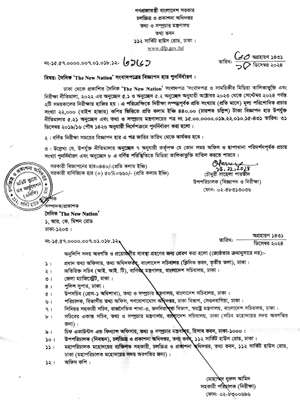Dr. Forqan Uddin Ahmed :
Bangladesh is currently suffering from an acute shortage of skilled workers and managers. The situation is deteriorating day by day as the shortage is intensifying in keeping up with the development process. Today, many firms, both local and international, are hiring foreign workers and managers to fill in the gap.
The skill shortage is not only an impediment in the current situation; it will become a major deterrent in achieving further growth in the future, if not addressed appropriately and urgently.
A 2019 report by the Bangladesh Institute of Development Studies (BIDS) revealed that various sectors such as ready-made garment (RMG), leather, ICT, infrastructure development, food processing, light engineering, healthcare, tourism, and ship-building industry will require several millions of skilled workers and experts by 2025.
Where will this skilled workforce come from? The country’s technical education and training centers as well as higher education institutes have long failed to keep up with the demand. Given the situation, is it worth considering a “brain gain” strategy as a viable alternative?
Training and human resource development co-exists. They are like the two sides of a coin. These things remain hidden and latent in everyman. With good leadership and managerial capabilities, they flourish. Human resource development (HRD) is the framework for helping employees develop their personal and organizational skills, knowledge and abilities.
Nation’s progress depends on human resources development. If people of state become proactive, dynamic it will be highly contributive with the skill they possess. In the present competitive world, only the fittest will survive, others cannot.
If the youth of the country want to stand on their own foot by achieving job excellence, the nation will undoubtedly make a stand towards the momentum of development. All people coming from walks of life should be highly skilled. If any fisherman from society have the knowledge of fishing and farmers have the knowledge in agricultural line it will help them.
In our country training is considered a loose subject. If any training infrastructure is visible somewhere – the real scenario or condition appears to be quite different from realities.
They are just an attempt to gain satisfaction by showing or preserving paper documentation or records in the file. The fake information is prepared and preserved. Courses are conducted by different names with an aim to objectify things and for achieving productive output.
To run the courses a huge amount is involved and courses are shown completed without ant purposeful result. Managers who are tasked with managing a nation, society or state should look after it. But so far no government of our state has thought about structural quality and excellence in this training sector? Every year national training day is being observed, as only for observance sake.
On this occasion no programs are chalked out from different ministries or from the government side. Only the Bangladesh Society for training and development (BSTD), a private organization and an autonomous body, takes the responsibility to observe the national training day.
This institute organizes a training seminar and exchanges views within the four walls of the BSTD office. Moreover, this organization also takes the responsibility of publishing a supplement covering state massages by the executive head and president of the country.
The training structure of the army is so strong that if the officers are posted here, the future career of that officer becomes very bright. Appointments and promotions are all based on merit. But in other civil administrations in Bangladesh it is opposite. However, Bangladesh Ansar VDP forces take field training and security very seriously.It is almost like the army.
This force can also be called a training based organization. However, due to their lack of organizational and logistical capacity, they are not able to engage in such constructive work in the development of the nation. But their potential is also abundant. Harnessing the field of potential can open up an infinite horizon of its potential manpower.
In order to augment our training, there must be a national commitment and a political commitment to self-criticism to make every human being a creative human being. The social structure has to be rearranged.
Infrastructural changes should be made. In the course of social change, infrastructure changes are necessary. All local government institutions that involve people, including health and education, should be prioritized for training work.
Parents, teachers and civil society should be made to trust the new trend and accept it as a movement for social change with the aim of adapting the students to the new curriculum and syllabus. In the light of relevance, laws, rules, regulations, circulars, policies etc. should be made viable and feasible for training which is pro human resource development.
For example, organization of cultural programs, painting competitions, sports competitions, writing competitions which can be held at school and college levels on the observance of training day.
Apart from this, seminars and workshops can be organized in the light of the importance and significance of the day in every educational institution, public and private office, court. On a priority basis, circulars can be issued as instructions from the highest levels of the nation.
And only then will we be able to stand tall with heads high. Otherwise we may be lost in the clutches of neo-colonialism. So, cautions a rise why we are lagging behind in formulating training policy.
In order to save the nation, our present interim government must go for strict implementation of all training courses and its proper exercise to make every human as creative and resourceful personnel. If humans are converted to assets, only then the nation will never be in crisis for job or suffer from poverty.
(The writer is a former Deputy Director General, Bangladesh Ansar and VDP; columnist and researcher.)



